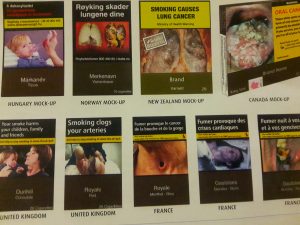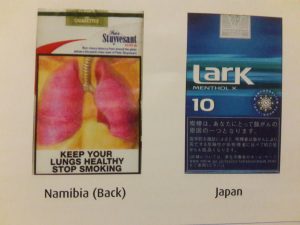Better graphic warnings on smoke packs but Africa is still lagging behind
 More countries across the world are demanding bigger warnings that feature pictures showing exactly how detrimental smoking can be. And governments are becoming more emboldened to call for plain cigarette packaging.
More countries across the world are demanding bigger warnings that feature pictures showing exactly how detrimental smoking can be. And governments are becoming more emboldened to call for plain cigarette packaging.
In Africa, however, only 10 of the 52 countries have pictorial warnings on the packages of cigarettes that get sold.
According to the fifth cigarette package health warning status report, internationally there has been tremendous progress in countries implementing pictorial health warnings on cigarette packaging. Released by the Canadian Cancer Society, the report provides an overview of cigarette pack warnings and ranks countries based on how well they have been able to implement pictorial health warnings.
Nepal, which requires cigarette manufacturers to to use pictorial health warnings that cover 90% of the front and back of the pack, is the highest ranked country. India, Thailand, Australia Sri Lanka and Uruguay were also among the top 10 countries with significant health warnings.
“Well-designed package warnings are a highly cost-effective means to increase awareness of the health effects and to reduce tobacco use. Pictures can convey a message with far more impact than a text only message can. The effectiveness of warnings increase with size,” the report states.
What the obligations are
Article 11 of the World Health Organisation’s frameworkconvetion on tobacco control, the global tobacco control treaty, calls formal packages to carry health warnings which describe harmful effects of tobacco use or other appropriate messages. These messages should cover at least 50% of the principal display area and should not cover less than 30%.
The messages must be in a national language and there must be several messages that are rotated. They should be printed on both the individual packets as well as the cartons and other packages sold to consumers.
“Where tobacco advertising is not yet banned, tobacco companies use colour pictures in tobacco advertising. The tobacco industry has often printed colour pictures on packages. If tobacco companies have used pictures to promote tobacco products, then governments should be able to use pictures to discourage tobacco use,” the convention states.
More than 100 countries across the world have pictorial warnings. At least 50% of the countries who have ratified the treaty require warnings that cover 50% of the front and back of the package.
Some changes

There has been progress since the last report in 2014. The Indian government has increased the size of the pictorial warnings from 20% of the pack to cover 85% of the pack.
There are also 14 countries where plain packaging is in process under formal consideration: New Zealand, Ireland, Norway, Slovenia. Canada, Uruguay, Thailand, Singapore, Belgium, Romania, Turkey, Finland, Chile and South Africa.
In Africa, South Africa is latest country to consider graphic health warnings. Ten African countries have pictorial health warnings: Chad, Kenya, Madagascar, Mauritius, Namibia and the Seychelles. Cameroon, Ghana, Gabon and Togo.
Mauritius was first to implement the graphic pictorial warnings in Africa introducing the mechanism in 2009. Madagascar came on board in 2012 while the Seychelles brought the first round of pictorial warnings in 2013 and revised them in 2016. Chad and Namibia introduced the mechanism in 2015 and Kenya started implementing pictorial warnings earlier in 2016.
In the region Chad has the largest picture warning covering 70% of the back and front of the cigarette pack. Togo, Mauritius and Namibia all have picture warnings exceeding 50% and are also considered better.
Plain packaging
In addition to improved graphic health warnings on cigarettes, there has also been an increased momentum around plain packaged cigarettes. According to the report, four countries have finalised requirements for plain packaging but 14 more countries are in the process of requiring plain packaging.
Australia implemented the policy in 2012 while France and the UK implemented it at manufacturer level in 2016. Hungary will implement by 2018. Those who are still in the process include New Zealand, Ireland, Norway, Canada, Slovenia Uruguay and Thailand among others. But Kenya, the Gambia Botswana and Brazil have expressed support to implement plain packaging in the future.
